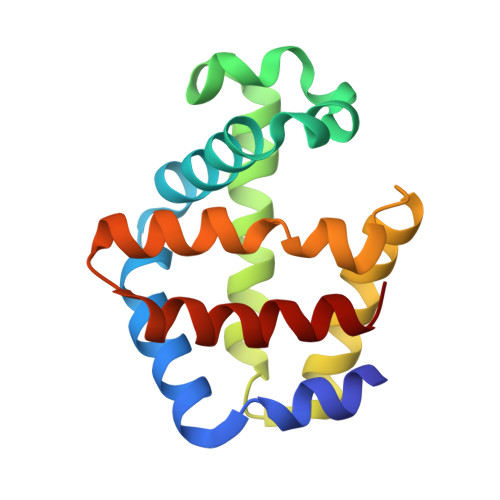Residue F4 plays a key role in modulating oxygen affinity and cooperativity in Scapharca dimeric hemoglobin
Knapp, J.E., Bonham, M.A., Gibson, Q.H., Nichols, J.C., Royer Jr., W.E.(2005) Biochemistry 44: 14419-14430
- PubMed: 16262242
- DOI: https://doi.org/10.1021/bi051052+
- Primary Citation of Related Structures:
2AUO, 2AUP, 2AUQ, 2AUR, 2AV0, 2AV3 - PubMed Abstract:
Residue F4 (Phe 97) undergoes the most dramatic ligand-linked transition in Scapharca dimeric hemoglobin, with its packing in the heme pocket in the unliganded (T) state suggested to be a primary determinant of its low affinity. Mutation of Phe 97 to Leu (previously reported), Val, and Tyr increases oxygen affinity from 8- to 100-fold over that of the wild type. The crystal structures of F97L and F97V show side chain packing in the heme pocket for both R and T state structures. In contrast, in the highest-affinity mutation, F97Y, the tyrosine side chain remains in the interface (high-affinity conformation) even in the unliganded state. Comparison of these mutations reveals a correlation between side chain packing in the heme pocket and oxygen affinity, indicating that greater mass in the heme pocket lowers oxygen affinity due to impaired movement of the heme iron into the heme plane. The results indicate that a key hydrogen bond, previously hypothesized to have a central role in regulation of oxygen affinity, plays at most only a small role in dictating ligand affinity. Equivalent mutations in sperm whale myoglobin alter ligand affinity by only 5-fold. The dramatically different responses to mutations at the F4 position result from subtle, but functionally critical, stereochemical differences. In myoglobin, an eclipsed orientation of the proximal His relative to the A and C pyrrole nitrogen atoms provides a significant barrier for high-affinity ligand binding. In contrast, the staggered orientation of the proximal histidine found in liganded HbI renders its ligand affinity much more susceptible to packing contacts between F4 and the heme group. These results highlight very different strategies used by cooperative hemoglobins in molluscs and mammals to control ligand affinity by modulation of the stereochemistry on the proximal side of the heme.
Organizational Affiliation:
Department of Biochemistry and Molecular Pharmacology, University of Massachusetts Medical School, Worcester, Massachusetts 01655, USA.
















